Arjuna information (story, facts, secrets, greatness, dharma, virtue) | What was Arjuna famous for? | What are the 10 names of Arjun? | How do you describe the character of Arjuna? | Who was Arjun’s favourite wife?
Namaste friends, how are you doing today? Welcome to #BhagavanBhakthi website / blog.
Bhagavan Lord Sri Krishna (Vishnu) (Rama) blessings to you and your family!
In this website / blog, you will always learn about #Hinduism #Sanskrit language.
Also subscribe to my YouTube channel from this link #BhagavanBhakthi to view videos about #Hinduism #Sanskrit language.
Just before going to “Arjuna information (story, facts, secrets, greatness, dharma, virtue) | What was Arjuna famous for? | What are the 10 names of Arjun? | How do you describe the character of Arjuna? | Who was Arjun’s favourite wife?“, let us know a brief, basic and very important information.
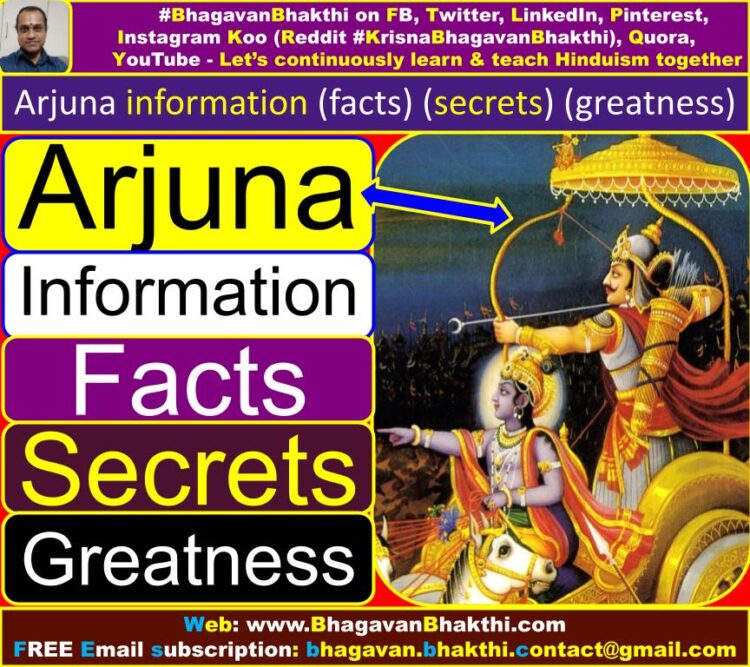
Meaning of the name Arjuna – There are multiple meanings of the word Arjuna, in that few meanings are silver, a tree name, very bright, superbly shiny, highly alert, etc.
Arjuna wives names are : Draupadi, Ulupi, Chitrangada and Subhadra. Ulupi is a Naga Kanya (Serpent woman), Chitrangada is an avatar of Sachi Devi (Indra’s wife) and Subhadra in her earlier life was Trijata (The demoness who was with Goddess Sita during Ramayana period).
Arjuna parents names are : King Pandu and Kunti Devi. Arjuna took birth with the blessings of Lord Sri Indra (The King of the Swarga Loka / Heaven). Position of Arjuna : Arjuna was highly respected and he was one of the main cause of the victory of the Mahabharata (Kurukshetra) war after Lord Krishna and Bhima.
Arjuna weapon name is : Gandiva Dhanush (Bow), Pashupatastra (An arrow), Agneyastra (Fire), Varunastra (Water), Vavayastra (Air), Parjanyastra (Cloud), etc. Arjuna siblings names are : Karna, Yudhishthira, Bhima, Nakula and Sahadeva.
Arjuna children names are : Iravan by Ulupi, Babruvahana by Chitrangada, Abhimanyu by Subhadra, Shrutakarma by Draupadi, Pragati and Pragya (twins – Both daughters) by Draupadi, Bhargavi (daughter) by Subhadra. Arjuna home is : Hastinapura (Hastinavati).
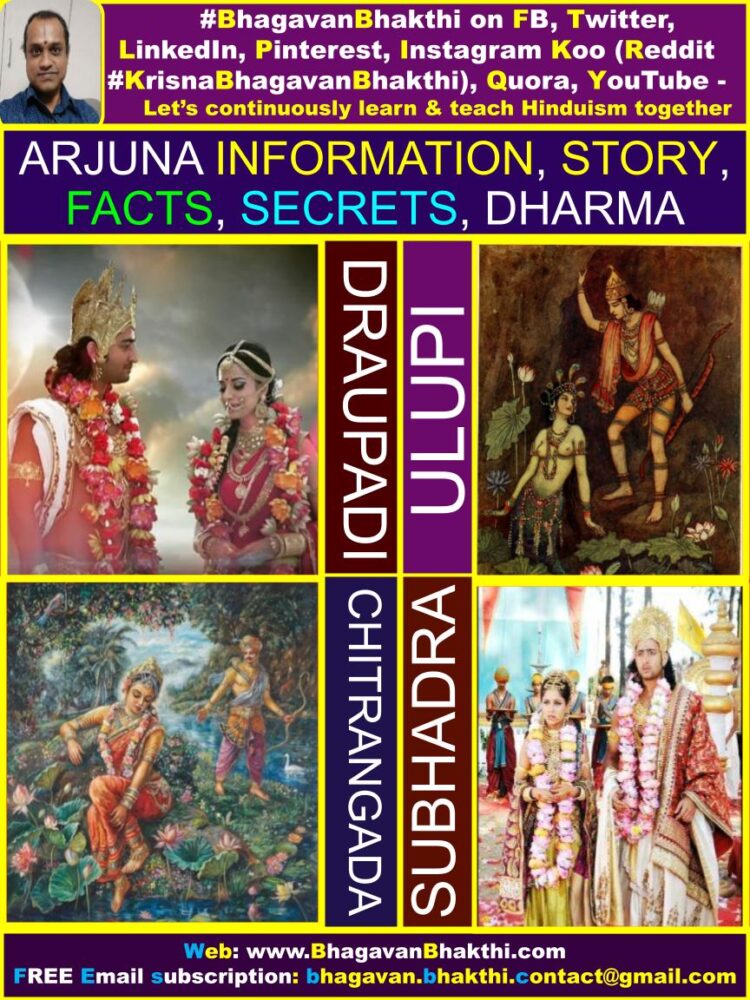
How Arjuna is related to Lord Krishna : King Shurasena and Queen Marisha’s children were Vasudeva [Lord Krishna’s father Vasudeva (वसुदेव)], Samudravijaya (son) and Pritha (Also called as Kunti) (daughter). Thus both Vasudeva (वसुदेव) and Kunti were brother and sister in relation. Consequently, Lord Krishna is a maternal cousin of Arjuna.
Different names of Arjuna are as given below with meanings of each name:
Kaunteya (कौन्तेय) : Arjuna was the son of Kunti. Here Kaunteya = Kunti + Teya = Mother + born from = Since Arjuna was born from Kunti Devi is called as Kaunteya. Kunti’s original name was Pritha. But, after the birth she was brought up by a foster father called Kuntibhoj and thus she is called as Kunti.
Pāṇḍuputra (पाण्डुपुत्र) : Arjuna was the son of King Pandu and thus this name. King Pandu had two wives, elder was Kunti and younger was Madri. Earlier King Pandu had got the curse from a Sage called Kidamba and his wife that “If King Pandu approaches his wives with the intention of making love, he will die.”
Pāṇḍava (पाण्डव) : Arjuna was the son of Pandu. Earlier all the five Pandavas and all the Dhritarashtra’s 100 sons were known as Kauravas. But, when Duryodhana started to play negative games with five Pandavas, they (Pandavas) were more than happy to be called as Pandavas, the sons of King Pandu.
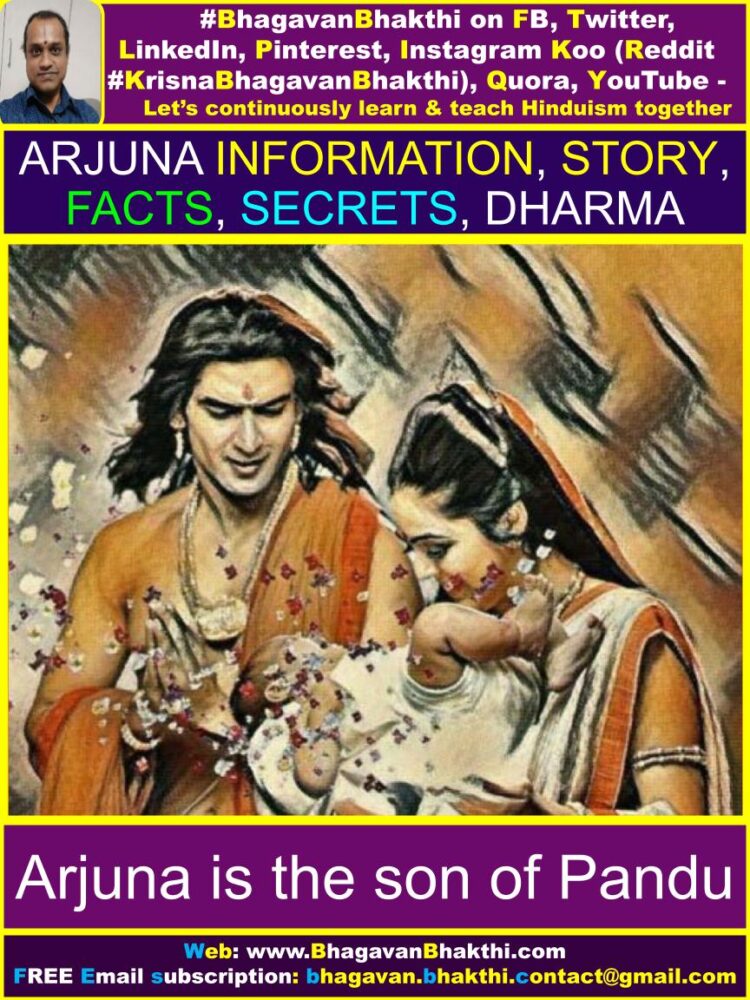
Pārtha (पार्थ) : Arjuna is the son of mother Pritha (Prutha / पृथा) (Original name of Kunti Devi). Pritha’s parents names are Shurasena and Marisha. But later, Pritha was handed over to another king named as Kuntibhoja and thus Pritha came to be known as Kunti, the daughter of Kuntibhoja.
Dhanañjaya (धनञ्जय) : Arjuna is someone had conquered the wealth and all the auspiciousness. This means, he was not a lobhi (greedy) person and never went behind the money and fame. Since he was a devotee of Lord Sri Krishna and Goddess Rukmini Devi, he was always prosperous through his life.
Anagha (अनघ) : Arjuna is someone who is sinless. Arjuna was a pure person and almost never went against the Dharma. He always followed Sanatana Dharma Shastras (Hindu Texts) and also practiced many rituals as per his Kshatriya Dharma. Moreover, he was a great devotee of Lord Sri Krishna.
Vijaya (विजय) : Arjuna was always victorious, invincible and undefeatable. As he was an avatar of Lord Indra, and with the blessings of Lord Sri Krishna he never lost any war against anyone. Someone who is a follower of Lord Sri Krishna, will never taste the fruit of defeat.
Guḍākesha (गुडाकेश) : Arjuna had conquered sleep. In Sanskrit Gudaka + Isha = Sleep + Lord = He was the Lord of the sleep, that is, he had complete control over his sleep and he was never wasting time in over sleep. Gudakesha also means, someone with abundant curly hair, that is, Guda + Kesha.
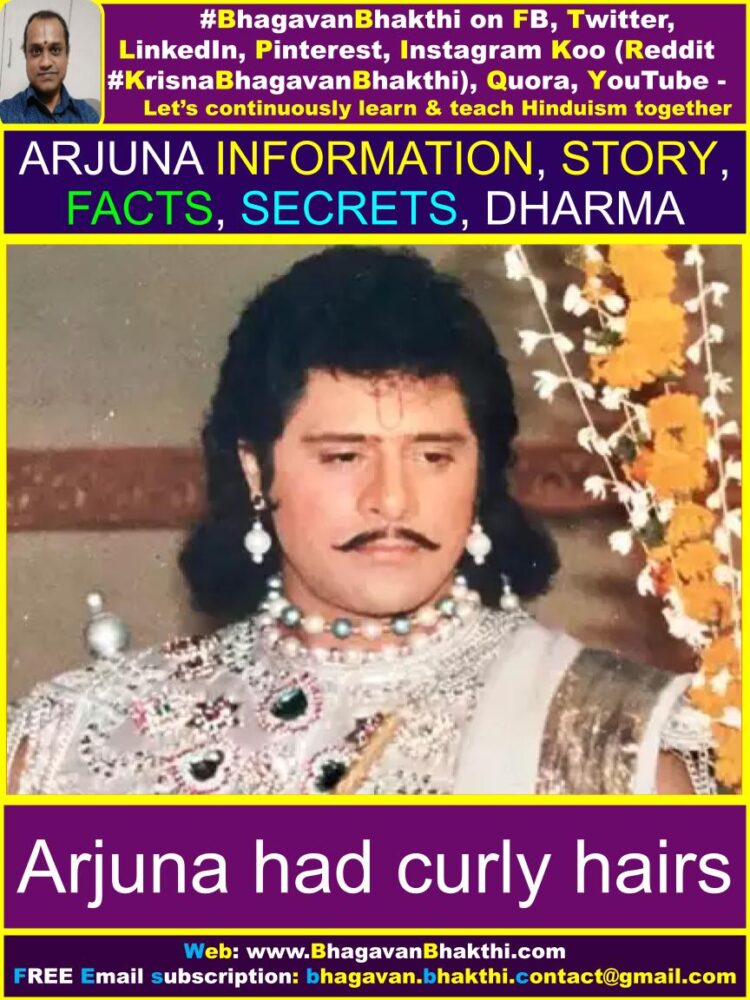
Bṛihannalā (बृहन्नला) : Arjuna assumed an eunuch form during the incognito exile (Agyatvas), that is, in the 13th year of their forest exile period. Arjuna was teaching classical dance to King Virat’s daughter Uttarakumari (Also called as Uttara). Arjuna was a master of the Hindu classical dance.
Phālguṇa (फाल्गुण) : Arjuna was born under the star (Nakshatra) Uttara Phalguni (Denebola in Leo) and thus Arjuna is also known as Phalguna. Arjuna was born on Srimukha Samvatsara, Phalguna month, Full Moon Day (Purnima Tithi) during the day in Uttara Phalguni Star (Nakshatra).
Mahābāhu (महाबाहु) : Arjuna was someone who had long and strong arms (shoulders). We should remember that he is an avatar of Lord Indra and he is not an ordinary human. In Sanskrit Mahabahu = Maha + Bahu = Great (Strong) + arms (shoulders).
Savyasāchī (सव्यसाची) : Arjuna is someone who can shoot arrows using the right and the left hand with equal consistency and accuracy (Ambidextrous). For this reason Lord Sri Krishna calls Arjuna as Savyasachi in Bhagavad Gita: Chapter 11, Verse 33.
Krishna (कृष्णा): Arjuna is someone who is of dark complexion and conducts great purity. Similar to Lord Sri Krishna, even Arjuna had the dark complexion and thus Arjuna is also known as Krishna. Likewise, Draupadi Devi, Lord (Sage) Vedavyasa Ji are also called as Krishna because of their dark complexion.
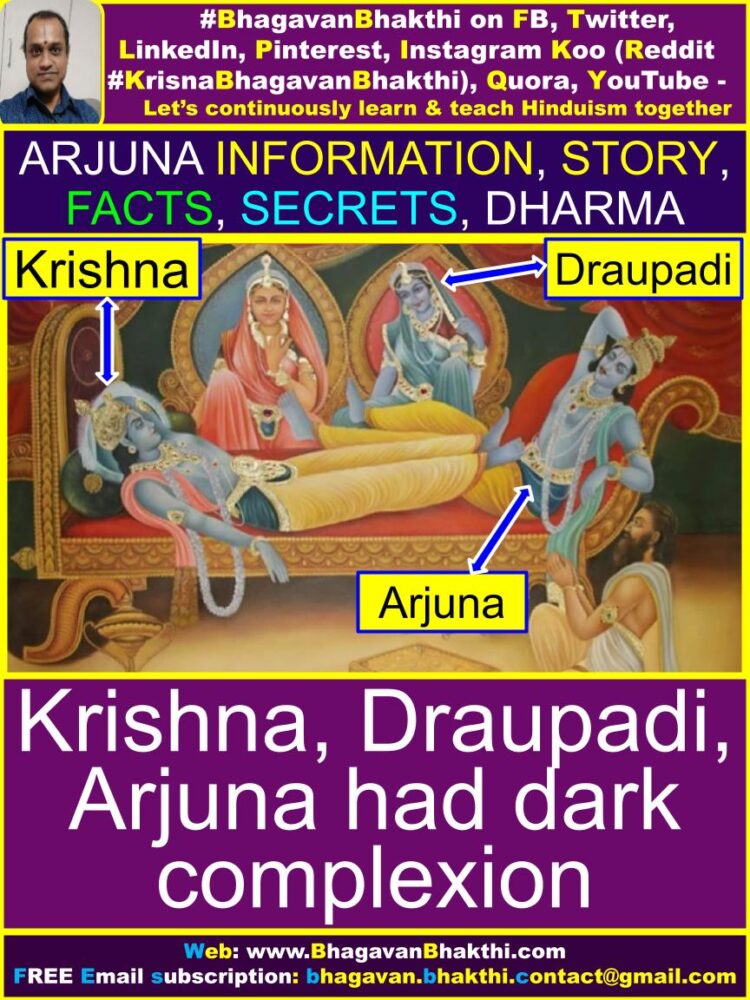
Jishṇu (जिष्णु) : Arjuna was always winning all the battles, he was always triumphant in all the wars and was conquering all his enemies. Originally Jishnu is the name of Lord Vishnu (Krishna). In Sri Vishnu Sahasranama, Lord Vishnu is called as Jishnu in Purna Peethika sloka number 22.
Shvetavāhana (श्वेतवाहन) : Arjuna is someone who had milky white horses mounted to his pure white chariot. Those four horses names are Saivya, Sugriva, Meghapushpa and Balahaka. The white horses always shows about the victory of Arjuna. Who can defeat Arjuna when Lord Sri Krishna himself is the charioteer.
Kirīṭī (किरीटी) : Arjuna is someone who wears the celestial crown presented by the Lord Sri Indra, The King of all the Demigods of the Swarga Loka (Heaven). This crown was no ordinary crown, it was a diadem which was studded with costly diamonds of the Swarga Loka (Heaven).
Gāṇḍīvadhārī (गाण्डीवधारी) or Gāṇḍīvi गाण्डीवी : Arjuna is the one who was holding a bow named Gandiva. Earlier, Lord Agni (The Fire God) gives this arrow called Gandiva to Arjuna. Along with Gandiva, Lord Agni also gives two quivers to Arjuna which would provide unlimited number of arrows to Arjuna.
Bībhatsu (बीभत्सु) : Arjuna is someone who always fights wars in a fair form, stylish way and terrific manner and never does anything horrible in the war which would go against the Dharma. Arjuna always followed the rules and regulations of the battles through out his life including in the Mahabharata (Kurukshetra) war.
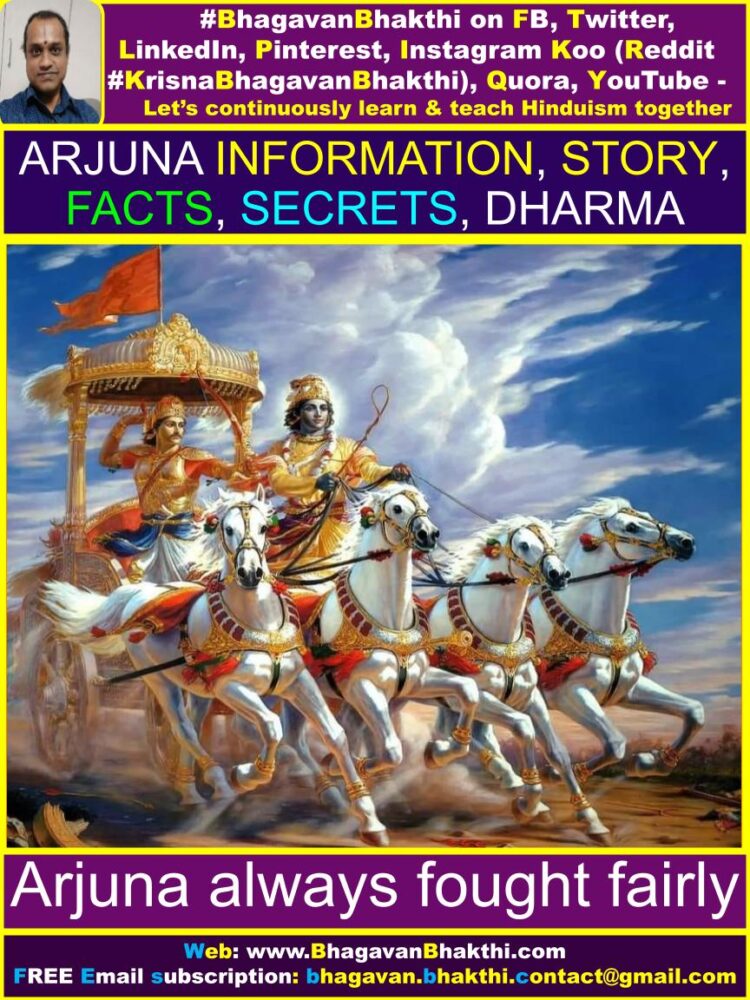
List of Arjuna information (story, facts, secrets, etc.) are as given below:
Gandiva : Lord Sri Agni Deva gives the Great Gandiva bow (Dhanush) to the Great Arjuna. Pashupatastra : Lord Shiva gifts the Great Pashupatastra to Arjuna, after Arjuna gratifies Lord Shiva with a long tapasya (penance).
Most favourite student : Arjuna was the most favourite student of Guru Dronacharya after Bhima. Arjuna defeated Karna : Arjuna defeated Karna, Bhishma, Dronacharya, Duryodhana, Kripacharya, Ashvatthama etc. multiple times including in the battle of Virat single handedly.
Bhishma and Karna never defeated Arjuna : Bhishma and Karna were never able to defeat the Great Arjuna in any battles. Arjuna’s astras (weapons) : Arjuna had Vaishnavastra, Brahmastra, Brahmashirastra, Pashupatastra etc.
Arjuna best friend of Lord Sri Krishna : He was one of the best friend of Lord Sri Krishna after Bhima. Arjuna destroyed many beasts : Arjuna easily destroyed many animals, beasts in Khandava forest and also Arjuna with the help of Lord Sri Agni (Fire God) and Lord Sri Krishna burnt the whole of the Khandava aranya / forest.
Arjuna’s name Krishna : Another name of Arjuna was Krishna, as Arjuna had the dark complexion like Lord Sri Krishna. Arjuna the Guru : Arjuna was the Guru of highly talented people like Abhimanyu, Satyaki, Pradyumna (Krishna son), Aniruddha (Pradyumna son, Krishna grandson), etc.
Arjuna’s sons : Arjuna had great warrior sons like Abhimanyu (from Subhadra), Babruvahana (from Chitrangada) and others. Ashvamedha Yagna : Arjuna single handedly defeated many many kings for the Ashvamedha yagna which was performed by his eldest brother Yudhishthira.
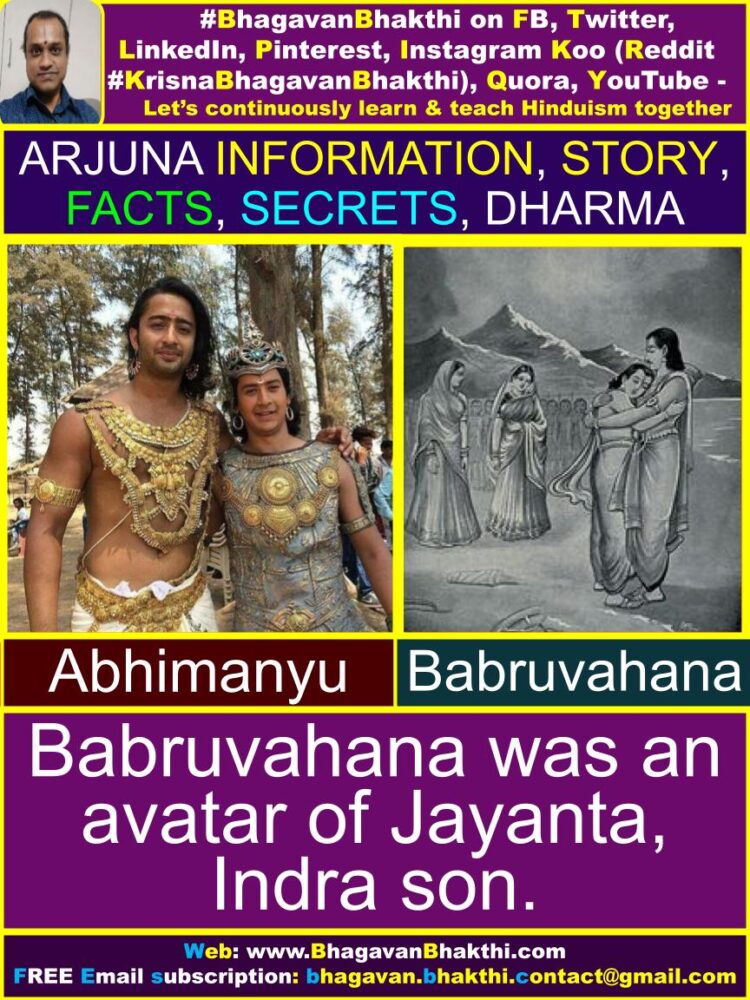
Arjuna defeated Karna in Draupadi Svayamvar : Arjuna easily defeated Karna in the Draupadi’s Svayamvara. Arjuna can shoot arrow in dark : Arjuna had learnt the art to shoot the arrow in the dark also.
Arjuna’s another name Gudakesha : Arjuna had a name called Gudakesha, which means someone who could conquer the senses easily. Arjuna had saved Duryodhana : Arjuna had ones saved Duryodhana against Gandharvas and had defeated Gandharvas’ leader Chitrasena.
Arjuna respected Bhima than other brothers : Arjuna had great respects for his elder brother Bhima more than the eldest brother Yudhishthira. Arjuna Shankha name : The Shankha / conch of Arjuna was called as Devadatta.
Arjuna best archer after Bhima : Arjuna was the best archer of his time after Bhima (many know that Bhima used to fight with only with Gadha / mace, but don’t know that Bhima was a much better archer than Arjuna).
Arjuna avatar of Indra Deva : Arjuna was the svayam avatar of Lord Sri Indra Deva. Arjuna / Indra Deva in his earlier life had taken avatar as Vali (during Tretayuga period, that is, during Sri Rama’s period). Arjuna and Subhadra : Arjuna married Lord Krishna’s sister Subhadra.
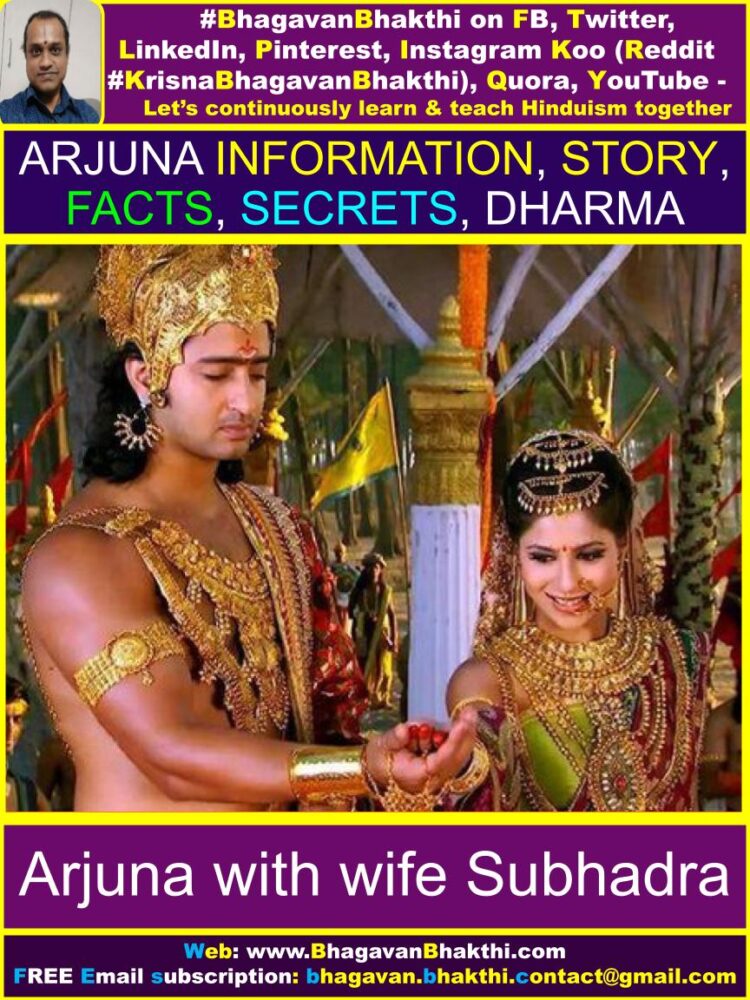
Arjuna and Urvashi : Once Urvashi proposes to Arjuna to make love with her. But Arjuna refuses this proposal and thus Urvashi slaps him and gives him curse to be born as woman. And thus Arjuna becomes Brihannala (Bruhannala) and teaches dance to Uttara Kumari during the incognito exile (Agyatvas) period.
Arjuna’s reaction after the battle of Mahabharata (Kurukshetra) : Arjuna, the Pandava Prince, after his victory in the Mahabharata (Kurukshetra) war started shout “I have won the battle, I have achieved it”. Lord Hanuman who was positioned himself on the flag of Arjuna’s chariot stabilizing and protecting it advised Arjuna like this –
“Arjuna, you won the war only because the almighty Lord Sri Krishna blessed you with this position. So, you should not get caught up in the ego of victory by yourself and forget the reality and the truth. So you should know the truths and glories of Lord Sri Krishna (Vishnu) through the right Guru.”
Arjuna begged Lord Hanuman to bless him for that. So, Lord Hanuman tells Arjuna, “After taking the incarnation of Bhima, I will be born as Madhva in Kali Yuga. At that time you will be born as a bull and you will hear all my teachings. After the bull birth, you will be enlightened about your previous births and will write commentaries on My Granthas (Hindu texts).”
[Note : Lord Indra (Arjuna) takes first takes an avatar of a bull in Kali Yuga and learn all about the Hindu Texts and later he takes the avatar as Sri Jayateertha Ji and writes commentaries on all the Texts of Sri Madhvacharya Ji. Sri Jayateertha Ji is also called as Teekacharya or Teekagudpadaru.]
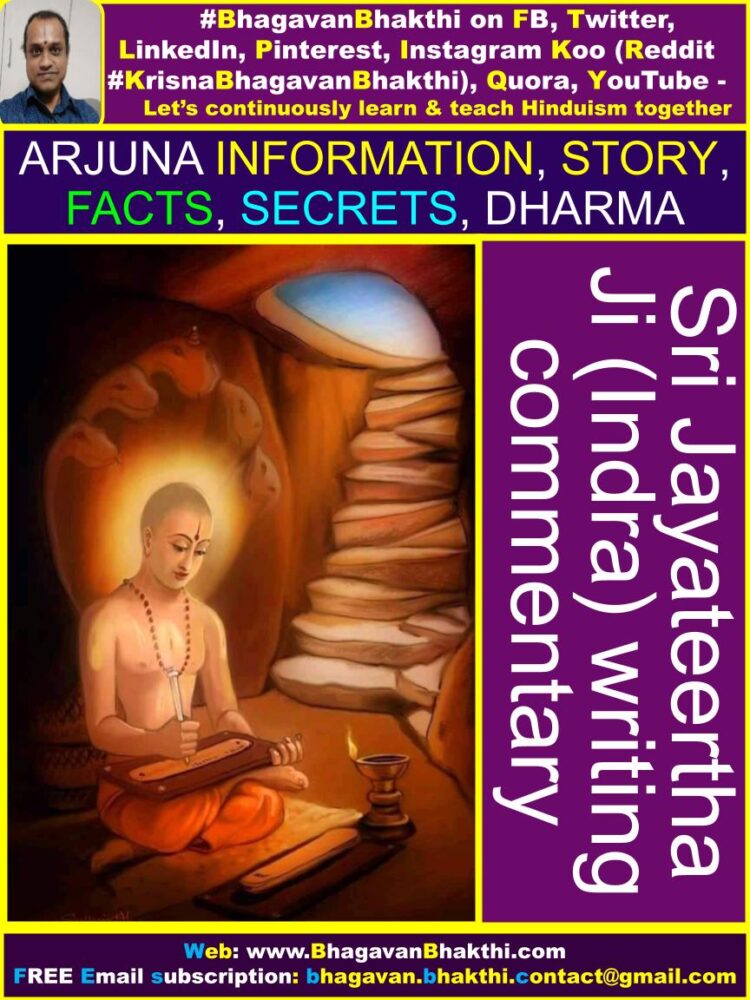
Information about Arjuna and Lord Shiva fight story is as given below:
Arjuna did tapasya (penance) of Lord Sri Vishnu and also Lord Shiva with his antaryami Lord Sri Vishnu at a place called Indrakila (इन्द्रकिला). After six months Arjuna saw a demon called “mookaasura (मूकासुर / mūkāsura)”, who came in the disguise of a pig.
Arjuna shot an arrow at the boar with his Gandiva bow (dhanush). Lord Shiva who came there in the form of Kirataka (Kiratak) shot those demons with his arrow. Mookasura, a demon disguised as a boar, died in his true form of Rakshasa (demon).
Now, Lord Shiva disguised as Kirataka (Kiratak) told Arjuna that he chased that boar, but Arjuna shot it, so asked him to fight with him. Thus, Arjuna agreed and a battle began between the two. Lord Shiva swallowed all the arrows fired by Arjuna. Now, Arjuna hit Lord Shiva with his Gandiva bow.
Lord Shiva laughed at Arjuna and swallowed Gandiva too. Accordingly both started fighting in Malla Yuddha (Kusti / wrestling). Arjuna was knocked unconscious by Lord Shiva’s severe blows. Later on regaining his consciousness, Arjuna repented of fighting with that Kiratak (Lord Shiva) and worshiped a Shivalinga nearby.
The flowers decorated by Arjuna on that Linga were falling on that Kirataka. Pleased by Arjuna’s worship, Lord Shiva gave him Pashupatastra (पाशुपतास्त्र).
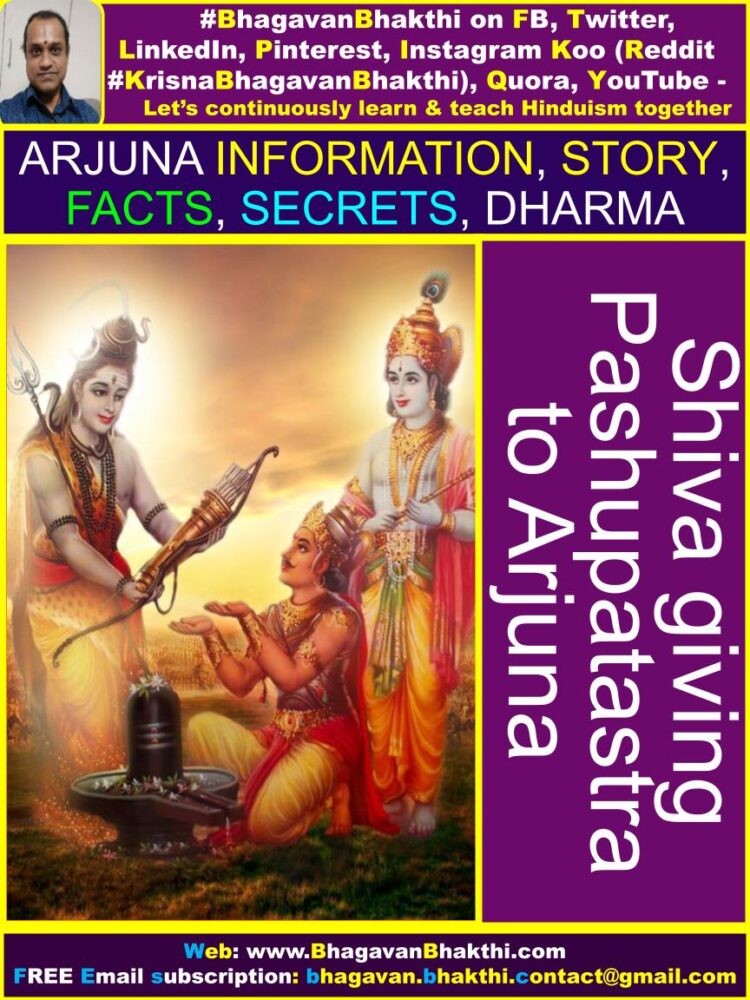
Pandavas Family God (Kuladevata) : Shami (Shamee) tree is the family god of Pandavas and also of Lord Sri Krishna. In Sri Srinivasa Kalyanam, Lord Sri Venkateswara tells that Shami (Shamee) tree is the Kuladevata (Family God) of both Pandavas and he himself).
On this same Shami (Shamee) tree all the five Pandavas had kept their weapons before the start of their incognito exile (Agyatvas) and then later entered the city of the King Virat. During this period of one year Arjuna takes the Brihannala form and teaches classical dance to Uttara (Uttarakumari).
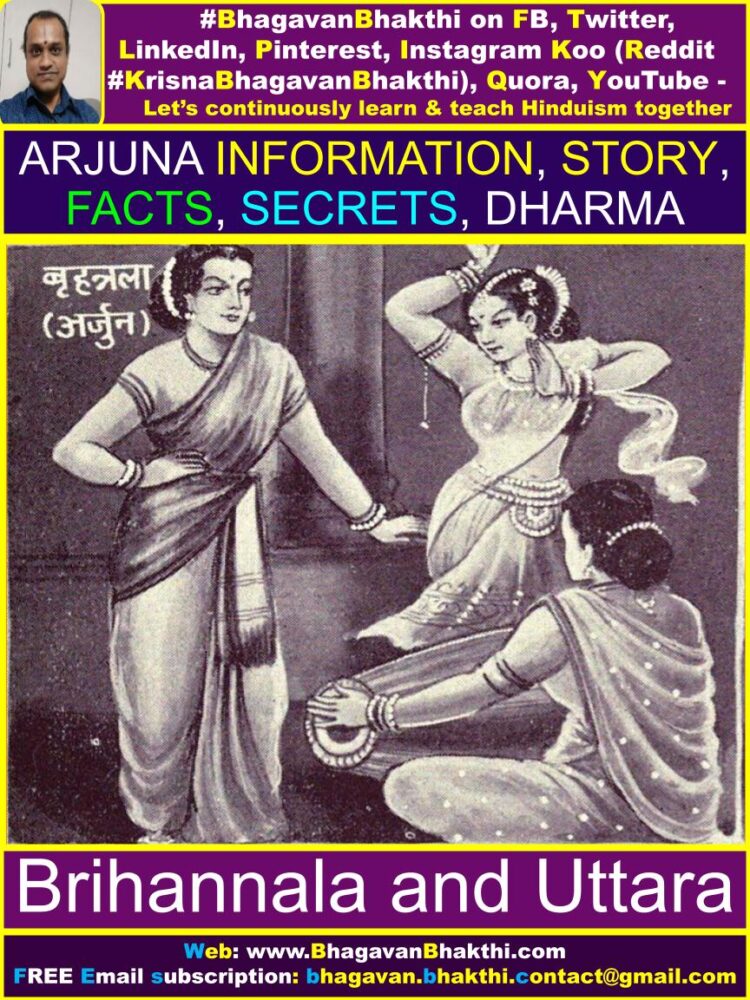
Ayudha Pooja and Arjuna (Pandavas) relationship : Ayudha Puja has been practiced since ancient times. The fact that on the day of Vijayadashami (Ayudha Pooja day) Arjuna retrieved his weapons hidden in the Shami (Shamee) tree to disguise himself (Agyatvas / Incognito exile) for the promised period may also account for the significance of Ayudhapuja.
It is believed that one who begins or renovates his learning to work on the Vijayadasami day (Ayudha Puja day) will secure a grand success as Arjuna did in Kurukshetra (Mahabharata) war.
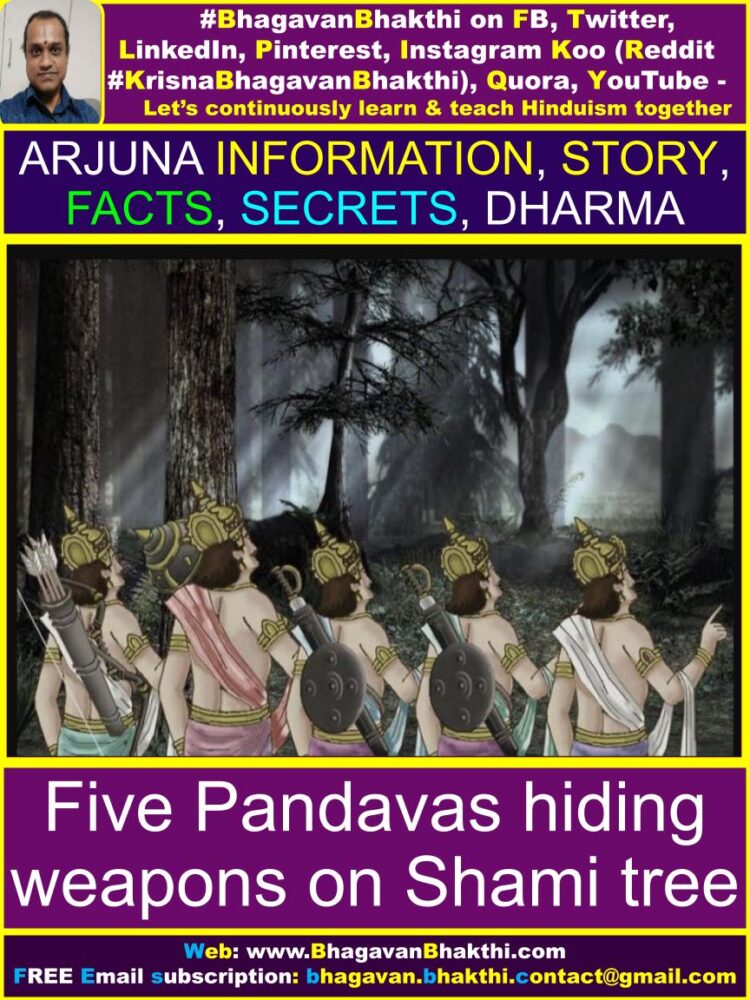
Representation of Pandavas and Kauravas in Mahabharata :
Yudhishthira : Yudhisthira represents Dharma. | Bhima : Bhima represents bhakti (devotion), jnana / gyan (knowledge), bala (strength) and 7 other virtues. | Arjuna : Arjuna represents shravana (hearing / listening) and manana (thoughtful remembering). | Nakula : Nakula represents sheela (character). |
Sahadeva : Sahadeva represents vinaya (humility). | Draupadi : Draupadi represents vidya (study / knowledge / Vedas). | Duryodhana : Duryodhana represents ajnana (ignorance). | Dushasana : Dushasana represents mithyajnana (Mythical knowledge). | Shakuni : Shakuni represents nastikya (atheism).
Information about birth days of Arjuna and other Pandavas and Kauravas is as given below:
Karna Birth : Karna an avatar of Lord Sri Surya (Sun God) was born on the Magha month of the Bright half (Shukla Paksha) 1st day (Pratipada tithi). It is said that he was older than Yudhisthira by 16 years. During the Mahabharata war, Karna was killed by Arjuna on Margashirsha month, Dark half (Krishna Paksha) on 14th Day (Chaturdashi tithi).
Yudhishthira Birth : Yudhishthira was born on Pajothpatti Samvatsara, Ashwin month, Bright half (Shukla Paksha), 5th day (Panchami Tithi), in Jyeshta nakshatra, in Sagittarius (Dhanu Rashi) Lagna, at midday Abhijit Muhurta (Mahurat). 127 year, 5 months and 25 days prior to start of Kaliyuga (roughly 3229-8-15 B.C).
Bhima Birth : Bhima was born on Agnirasa Samvatsara, Ashwin month, Dark half (Krishna Paksha), 9th day (Navami Tithi) in Magha Star (Nakshatra), after midday. He was younger than Yudhishthira by 1 year and 19 days. He was an avatar of Lord Sri Vayu Deva.
Arjuna Birth : Arjuna was born on Srimukha Samvatsara, Phalguna month, Full Moon Day (Purnima Tithi) during the day in Uttara Phalguni Star (Nakshatra). Younger than Bhima by 1 year 4 months and 21 days. Arjuna is an avatar of Lord Sri Indra Deva.
Nakula and Sahadeva Birth : Both Nakula and Sahadeva were born on Bhava Samvatsara, Phalguna month, New Moon day (Amavasya Tithi), Midday, in Ashwini Star (Nakshatra).
Both Nakula and Sahadeva were younger than Arjuna by 1 year, 0 month, and 15 days. They were the avatars of Ashwini brother Nasatya and Dasra.
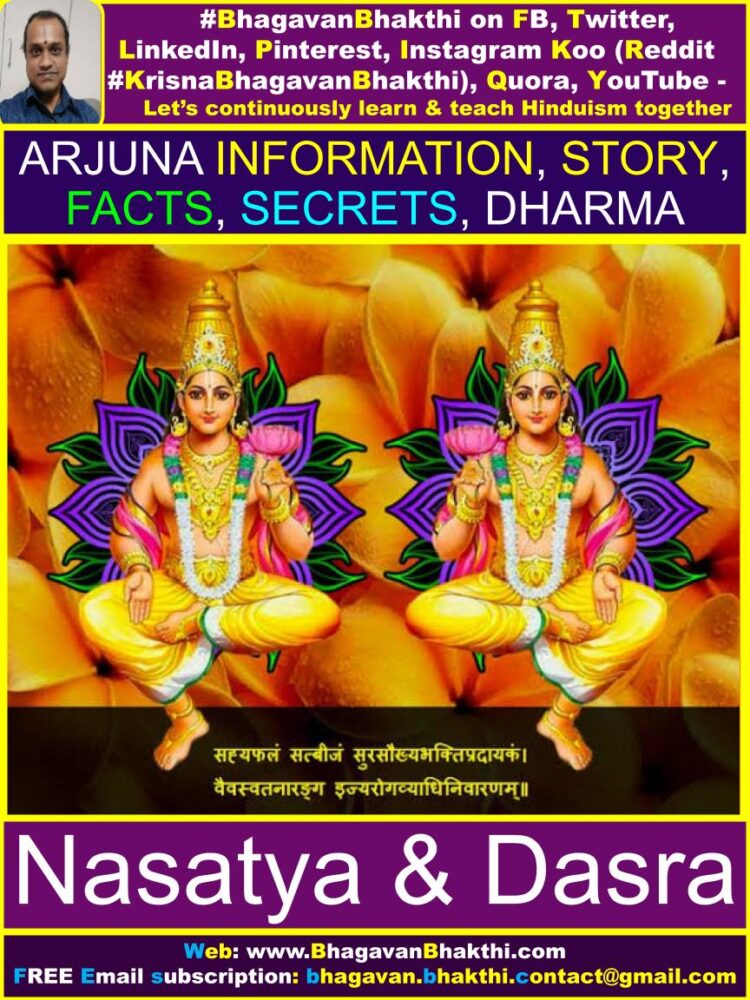
Lord Sri Krishna Birth : He is unborn. But as a pastime he takes the avatar (not birth) on Shrimukha Samvatsara, Shravana month, Dark half (Krishna Paksha), 8th day (Ashtami Tithi), just after midnight in Taurus Lagna (Vrishabha Rashi). He is avatar of Lord Sri Vishnu. There is no difference between Lord Vishnu and Krishna avatar.
Duryodhana Birth : Just one day after the mighty Bhima’s birth Duryodhana was born. From that day onwards everyday the rest of the 99 Kauravas (boys) and their only sister were born. Similarly, Hidimba, Bakasura and Kichaka were born in the same period between Magha and Swati Stars (Nakshatras).
Duryodhana’s Death : He lost the battle against the mighty Bhima on Margashirsha month, New Moon Day (Amavasya Tithi) / Pausha Bright half (Shukla Paksha) in the evening. He died the next morning on the Bright half (Shukla Paksha), 1st Day (Pratipada Tithi).
Yudhishthira became Yuvaraja (Crowned Prince) : Yudhishthira became Crowned Prince (Yuvaraja) of Hastinapura (Hastinavati) on Shubhakrit Samvatsara, Ashwayuja month, Bright half (Shukla Paksha), 10th day (Dashami Tithi) when he was 31 years, 0 month and 5 days old.
Yudhishthira became King of Hastinapura : Yudhishthira was crowned as the King of Hastinapura (Hastinavati) on Shubhakrit Samvatsara, Pausha month, Full Moon Day (Purnima). Yudhishthira was 91 year, 3 months and 10 days old when he became the King (Samrat / Chakravartin / Emperor) of the whole world.
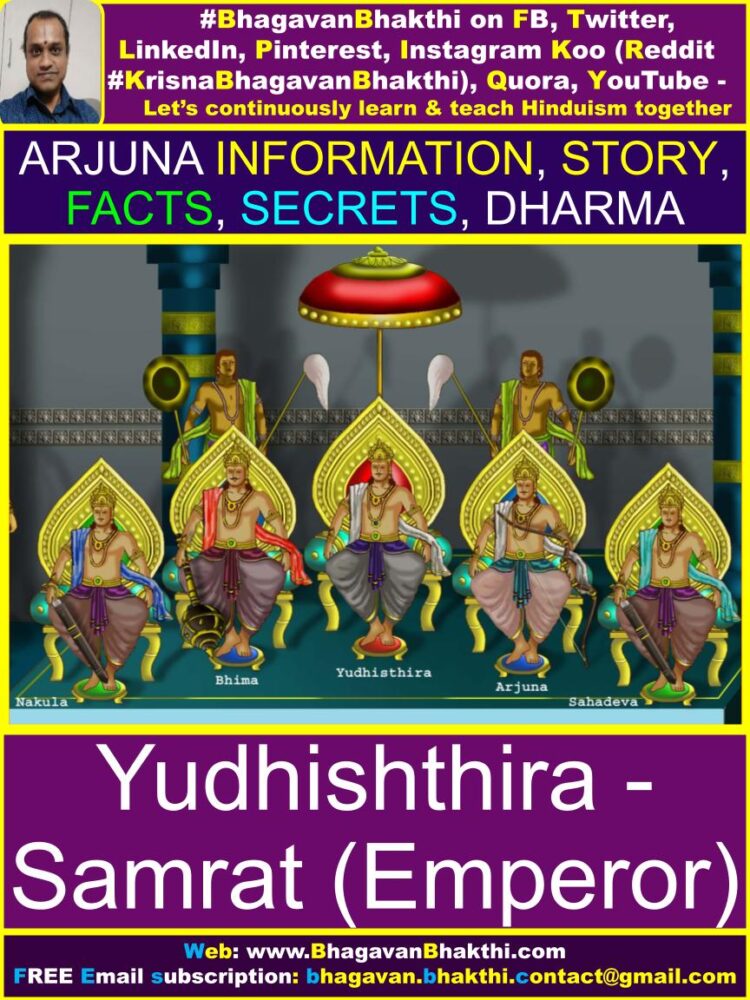
Yudhishthira ruled for the whole world for 36 years, 2 months and 15 days. From Shubhakrit Samvatsara, Pushya month, Full Moon Day (Purnima Tithi) to Bahudhanya Samvatsara, Pushya month, Full Moon Day (Purnima Tithi). It was 36 years, 2 months and 15 days.
It was Pramadi Samvatsara, Bright half (Shukla Paksha), 1st Day (Pratipada Tithi) Lord Shri Krishna finished his avatar on this earth, that is, on B.C 3102-2-20 at 2-27-30 P.M. Originally Kali Yuga started when Duryodhana died.
Seven days later, on Bright half (Shukla Paksha), 7th Day (Saptami Titihi), whole of the Dwarka city was submerged in the Ocean. Saptarishis (Seven Sages) were in Magha Star (Nakshatra). Yudhishthira Shaka started from his coronation day, that is, Lord Sri Krishna finished his Avatar in Yudhishthira Shaka. Total there were 36 years, 2 months and 15 days in Yudhishthira Shaka.
Pandavas started for their Final journey after Yudhishthira Shaka on Pramadi Samvatsara, Ashwayuja month, Bright half (Shukla Paksha), 12th Day (Dwadashi Tithi). At that time, Yudhishthira was aged 128 years, 0 month and 6 days. Parikshit was 36 years old at that time, and he (Parikshit) was coronated on the same day at Hastinapur (Hastinavati).
King Parikshit ruled the whole world for 60 years. After he got the curse from Sage Shringi (son of Sage Shamika), King Parikshit coronated his 25 year old son Janamejaya, and died after hearing the Srimad Bhagavatam under Sage Shuka Muni (Shukacharya – son of Lord Sri Vedavyasa).
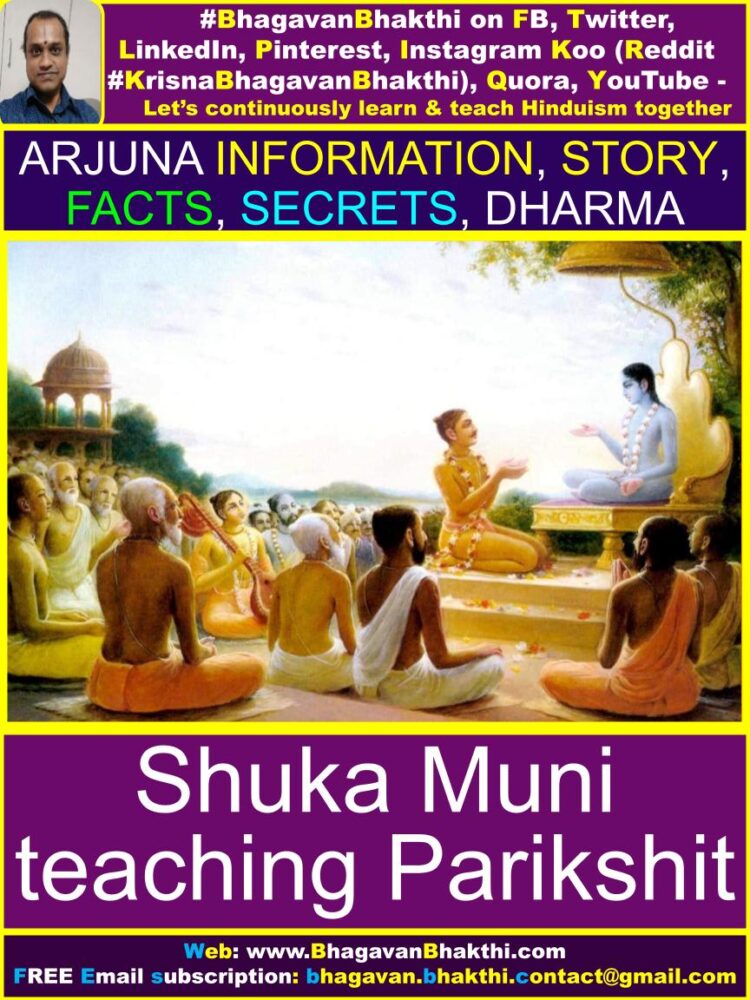
King Parikshit is believed to be an avatar (reincarnation) of Satya (Krita) Yuga, the personified first Yuga as per Hindu Sanatana Dharma. Shakuni the maternal uncle of Duryodhana is an avatar of Dvapara Yuga (In Sanskrit Dvapara means uncertainty, doubt). Duryadhana is an avatar of Kali Yuga’s Kali.
Arjuna Kruta (Krita) Sri Durga Stuti (Stotram) is as given below in Sanskrit (Hindi), Kannada and English languages:
Before the start of the Mahabharata (Kurukshetra) war, Lord Sri Krishna directs Arjuna to pray to Goddess Durga Devi to ensure victory over the Kauravas in the upcoming war.
Accordingly as per the instructions of Lord Sri Krishna, Arjuna prayed to Goddess Durga with a hymn (stotra, stuti) popularly known as Arjuna Krita (Kruta) Sri Durga Stuti (Stotram). Pleased by Arjuna’s prayers, Goddess Durga Devi appears before him and bestows the boon of victory over the Kauravas in battle.
This hymn is found in the epic Mahabharata – Bhishma Parva. Anyone who recites this Durga Stuti (Stotram) with sincere devotion and faith will get good health, wealth, prosperity, success in all their endeavors and victory over enemies.
One who recites this famous Durga Stotra regularly will be fearless, will not be troubled by evil spirits and will not overcome obstacles in life. Worshiping Goddess Durga with this prayer is very effective and useful when recited during Rahu-kala, especially for those passing through Rahu dasha or afflicted by Rahu dosha.
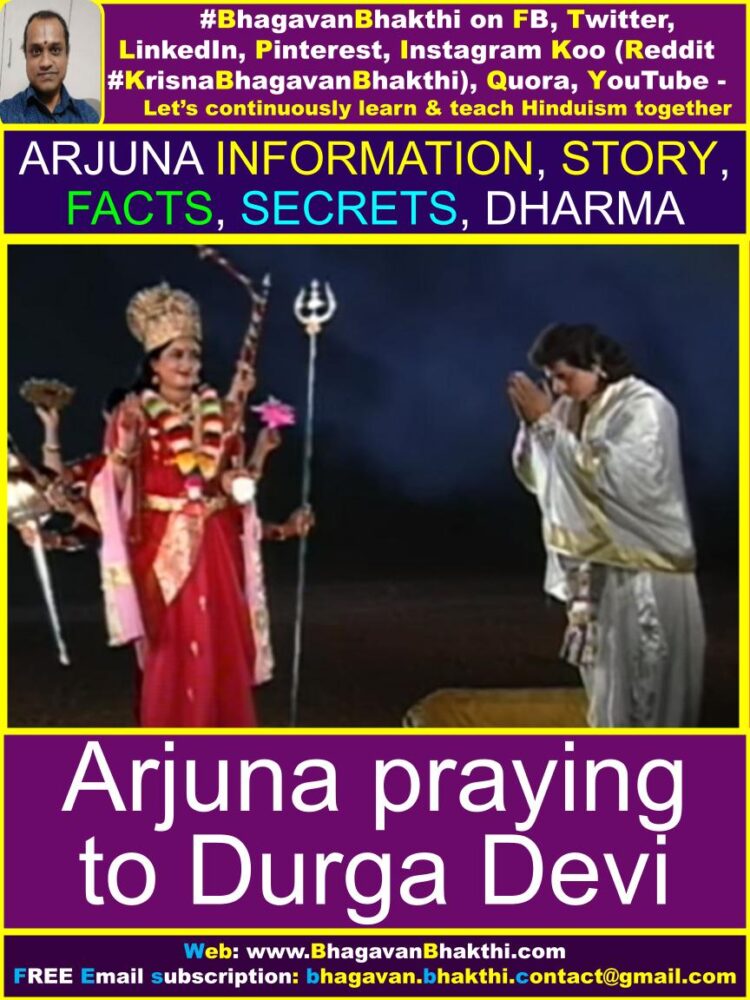
Arjuna Kruta (Krita) Sri Durga Stuti (Stotram) is as given below in Sanskrit (Hindi) language:
अर्जुन उवाच । नमस्ते सिद्धसेनानि आर्ये मन्दरवासिनि ।
कुमारि कालि कापालि कपिले कृष्णपिङ्गले ॥ १ ॥
भद्रकालि नमस्तुभ्यं महाकालि नमोऽस्तु ते ।
चण्डि चण्डे नमस्तुभ्यं तारिणि वरवर्णिनि ॥ २ ॥
कात्यायनि महाभागे करालि विजये जये ।
शिखिपिञ्छध्वजधरे नानाभरणभूषिते ॥ ३ ॥
अट्टशूलप्रहरणे खड्गखेटकधारिणि ।
गोपेन्द्रस्यानुजे ज्येष्ठे नन्दगोपकुलोद्भवे ॥ ४ ॥
महिषासृक्प्रिये नित्यं कौशिकि पीतवासिनि ।
अट्टहासे कोकमुखे नमस्तेऽस्तु रणप्रिये ॥ ५ ॥
उमे शाकम्भरि श्वेते कृष्णे कैटभनाशिनि ।
हिरण्याक्षि विरूपाक्षि सुधूम्राक्षि नमोऽस्तु ते ॥ ६ ॥
वेदश्रुतिमहापुण्ये ब्रह्मण्ये जातवेदसि ।
जम्बूकटकचैत्येषु नित्यं सन्निहितालये ॥ ७ ॥
त्वं ब्रह्मविद्या विद्यानां महानिद्रा च देहिनाम् ।
स्कन्दमातर्भगवति दुर्गे कान्तारवासिनि ॥ ८ ॥
स्वाहाकारः स्वधा चैव कला काष्ठा सरस्वती ।
सावित्री वेदमाता च तथा वेदान्त उच्यते ॥ ९ ॥
स्तुतासि त्वं महादेवि विशुद्धेनान्तरात्मना ।
जयो भवतु मे नित्यं त्वत्प्रसादाद्रणाजिरे ॥ १० ॥
कान्तारभयदुर्गेषु भक्तानां चालयेषु च ।
नित्यं वससि पाताले युद्धे जयसि दानवान् ॥ ११ ॥
त्वं जम्भनी मोहिनी च माया ह्रीः श्रीस्तथैव च ।
सन्ध्या प्रभावती चैव सावित्री जननी तथा ॥ १२ ॥
तुष्टिः पुष्टिर्धृतिर्दीप्तिश्चन्द्रादित्यविवर्धिनी ।
भूतिर्भूतिमतां सङ्ख्ये वीक्ष्यसे सिद्धचारणैः ॥ १३ ॥
| इति श्रीमन्महाभारते भीष्मपर्वणि त्रयोविंशोऽध्याये अर्जुन कृत श्री दुर्गा स्तोत्रम् ।
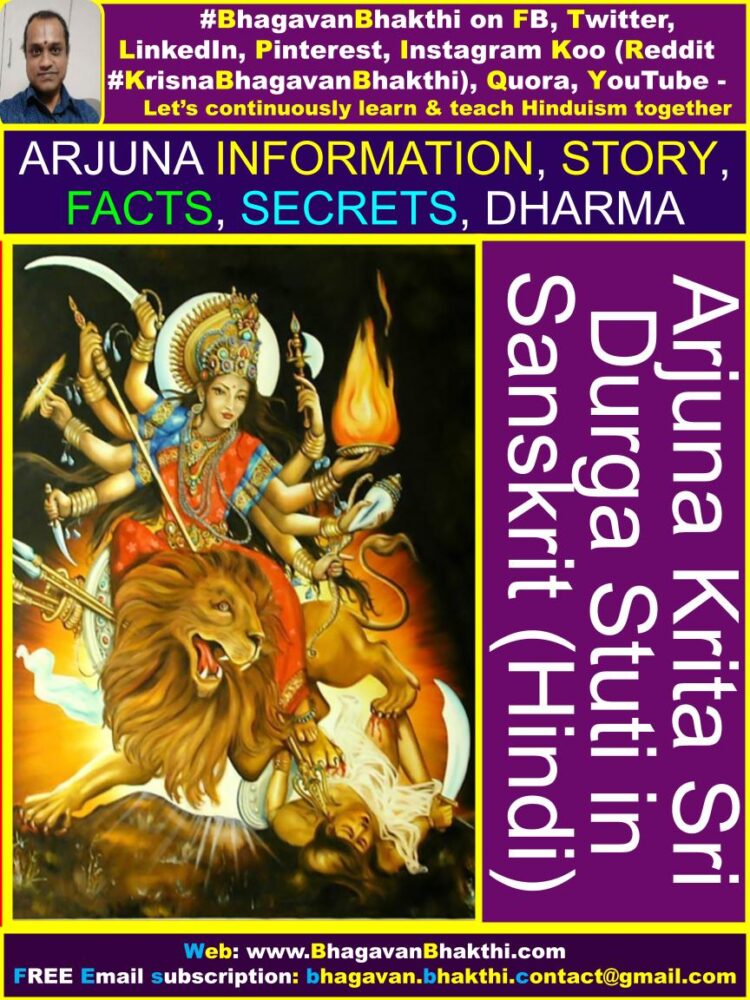
Arjuna Kruta (Krita) Sri Durga Stuti (Stotram) is as given below in Kannada language:
ಅರ್ಜುನ ಉವಾಚ | ನಮಸ್ತೇ ಸಿದ್ಧಸೇನಾನಿ ಆರ್ಯೇ ಮಂದರವಾಸಿನಿ |
ಕುಮಾರಿ ಕಾಳಿ ಕಾಪಾಲಿ ಕಪಿಲೇ ಕೃಷ್ಣಪಿಂಗಳೇ || ೧ ||
ಭದ್ರಕಾಳಿ ನಮಸ್ತುಭ್ಯಂ ಮಹಾಕಾಳಿ ನಮೋಽಸ್ತು ತೇ |
ಚಂಡಿ ಚಂಡೇ ನಮಸ್ತುಭ್ಯಂ ತಾರಿಣಿ ವರವರ್ಣಿನಿ || ೨ ||
ಕಾತ್ಯಾಯನಿ ಮಹಾಭಾಗೇ ಕರಾಳಿ ವಿಜಯೇ ಜಯೇ |
ಶಿಖಿಪಿಂಛಧ್ವಜಧರೇ ನಾನಾಭರಣಭೂಷಿತೇ || ೩ ||
ಅಟ್ಟಶೂಲಪ್ರಹರಣೇ ಖಡ್ಗಖೇಟಕಧಾರಿಣಿ |
ಗೋಪೇಂದ್ರಸ್ಯಾನುಜೇ ಜ್ಯೇಷ್ಠೇ ನಂದಗೋಪಕುಲೋದ್ಭವೇ || ೪ ||
ಮಹಿಷಾಸೃಕ್ಪ್ರಿಯೇ ನಿತ್ಯಂ ಕೌಶಿಕಿ ಪೀತವಾಸಿನಿ |
ಅಟ್ಟಹಾಸೇ ಕೋಕಮುಖೇ ನಮಸ್ತೇಽಸ್ತು ರಣಪ್ರಿಯೇ || ೫ ||
ಉಮೇ ಶಾಕಂಭರಿ ಶ್ವೇತೇ ಕೃಷ್ಣೇ ಕೈಟಭನಾಶಿನಿ |
ಹಿರಣ್ಯಾಕ್ಷಿ ವಿರೂಪಾಕ್ಷಿ ಸುಧೂಮ್ರಾಕ್ಷಿ ನಮೋಽಸ್ತು ತೇ || ೬ ||
ವೇದಶ್ರುತಿಮಹಾಪುಣ್ಯೇ ಬ್ರಹ್ಮಣ್ಯೇ ಜಾತವೇದಸಿ |
ಜಂಬೂಕಟಕಚೈತ್ಯೇಷು ನಿತ್ಯಂ ಸನ್ನಿಹಿತಾಲಯೇ || ೭ ||
ತ್ವಂ ಬ್ರಹ್ಮವಿದ್ಯಾ ವಿದ್ಯಾನಾಂ ಮಹಾನಿದ್ರಾ ಚ ದೇಹಿನಾಮ್ |
ಸ್ಕಂದಮಾತರ್ಭಗವತಿ ದುರ್ಗೇ ಕಾಂತಾರವಾಸಿನಿ || ೮ ||
ಸ್ವಾಹಾಕಾರಃ ಸ್ವಧಾ ಚೈವ ಕಲಾ ಕಾಷ್ಠಾ ಸರಸ್ವತೀ |
ಸಾವಿತ್ರೀ ವೇದಮಾತಾ ಚ ತಥಾ ವೇದಾಂತ ಉಚ್ಯತೇ || ೯ ||
ಸ್ತುತಾಸಿ ತ್ವಂ ಮಹಾದೇವಿ ವಿಶುದ್ಧೇನಾಂತರಾತ್ಮನಾ |
ಜಯೋ ಭವತು ಮೇ ನಿತ್ಯಂ ತ್ವತ್ಪ್ರಸಾದಾದ್ರಣಾಜಿರೇ || ೧೦ ||
ಕಾಂತಾರಭಯದುರ್ಗೇಷು ಭಕ್ತಾನಾಂ ಚಾಲಯೇಷು ಚ |
ನಿತ್ಯಂ ವಸಸಿ ಪಾತಾಳೇ ಯುದ್ಧೇ ಜಯಸಿ ದಾನವಾನ್ || ೧೧ ||
ತ್ವಂ ಜಂಭನೀ ಮೋಹಿನೀ ಚ ಮಾಯಾ ಹ್ರೀಃ ಶ್ರೀಸ್ತಥೈವ ಚ |
ಸಂಧ್ಯಾ ಪ್ರಭಾವತೀ ಚೈವ ಸಾವಿತ್ರೀ ಜನನೀ ತಥಾ || ೧೨ ||
ತುಷ್ಟಿಃ ಪುಷ್ಟಿರ್ಧೃತಿರ್ದೀಪ್ತಿಶ್ಚಂದ್ರಾದಿತ್ಯವಿವರ್ಧಿನೀ |
ಭೂತಿರ್ಭೂತಿಮತಾಂ ಸಂಖ್ಯೇ ವೀಕ್ಷ್ಯಸೇ ಸಿದ್ಧಚಾರಣೈಃ || ೧೩ ||
| ಇತಿ ಶ್ರೀಮನ್ಮಹಾಭಾರತೇ ಭೀಷ್ಮಪರ್ವಣಿ ತ್ರಯೋವಿಂಶೋಽಧ್ಯಾಯೇ ಅರ್ಜುನ ಕೃತ ಶ್ರೀ ದುರ್ಗಾ ಸ್ತೋತ್ರಮ್ |
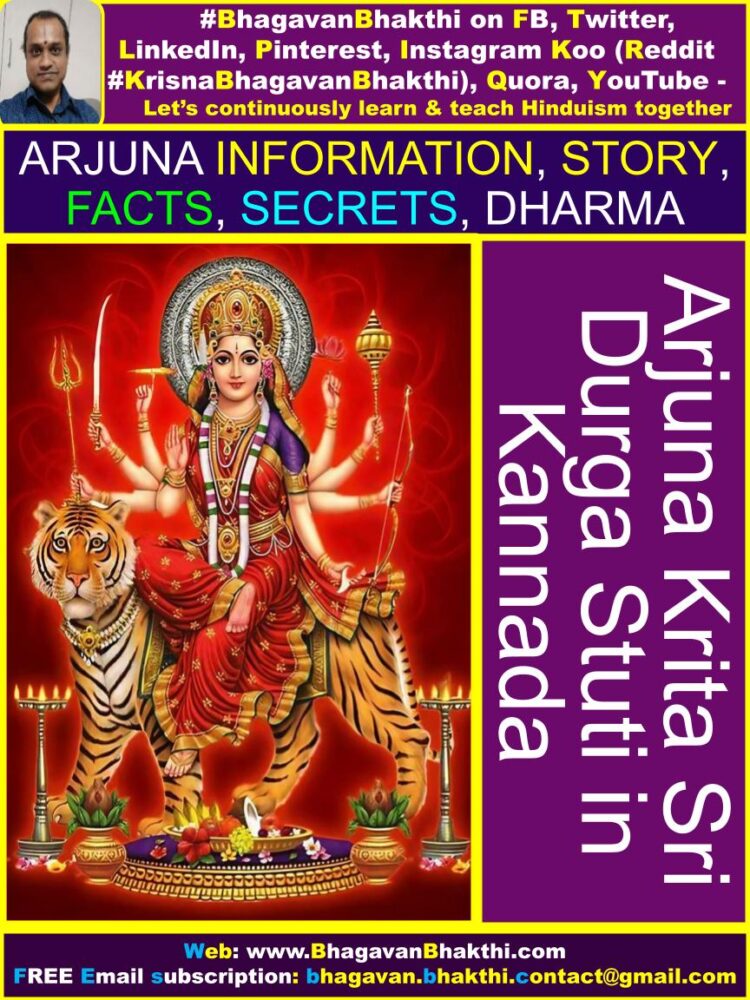
Arjuna Kruta (Krita) Sri Durga Stuti (Stotram) is as given below in English language:
Arjuna uvāca | namastē sid’dhasēnāni āryē mandaravāsini |
kumāri kāḷi kāpāli kapilē kr̥ṣṇapiṅgaḷē || 1 ||
bhadrakāḷi namastubhyaṁ mahākāḷi namō̕stu tē |
caṇḍi caṇḍē namastubhyaṁ tāriṇi varavarṇini || 2 ||
kātyāyani mahābhāgē karāḷi vijayē jayē |
śikhipin̄chadhvajadharē nānābharaṇabhūṣitē || 3 ||
aṭṭaśūlapraharaṇē khaḍgakhēṭakadhāriṇi |
gōpēndrasyānujē jyēṣṭhē nandagōpakulōdbhavē || 4 ||
mahiṣāsr̥kpriyē nityaṁ kauśiki pītavāsini |
aṭṭahāsē kōkamukhē namastē̕stu raṇapriyē || 5 ||
umē śākambhari śvētē kr̥ṣṇē kaiṭabhanāśini |
hiraṇyākṣi virūpākṣi sudhūmrākṣi namō̕stu tē || 6 ||
vēdaśrutimahāpuṇyē brahmaṇyē jātavēdasi |
jambūkaṭakacaityēṣu nityaṁ sannihitālayē || 7 ||
tvaṁ brahmavidyā vidyānāṁ mahānidrā ca dēhinām |
skandamātarbhagavati durgē kāntāravāsini || 8 ||
svāhākāraḥ svadhā caiva kalā kāṣṭhā sarasvatī |
sāvitrī vēdamātā ca tathā vēdānta ucyatē || 9 ||
stutāsi tvaṁ mahādēvi viśud’dhēnāntarātmanā |
jayō bhavatu mē nityaṁ tvatprasādādraṇājirē || 10 ||
kāntārabhayadurgēṣu bhaktānāṁ cālayēṣu ca |
nityaṁ vasasi pātāḷē yud’dhē jayasi dānavān || 11 ||
tvaṁ jambhanī mōhinī ca māyā hrīḥ śrīstathaiva ca |
sandhyā prabhāvatī caiva sāvitrī jananī tathā || 12 ||
tuṣṭiḥ puṣṭirdhr̥tirdīptiścandrādityavivardhinī |
bhūtirbhūtimatāṁ saṅkhyē vīkṣyasē sid’dhacāraṇaiḥ || 13 ||
| iti śrīmanmahābhāratē bhīṣmaparvaṇi trayōvinśō̕dhyāyē arjuna kr̥ta śrī durgā stōtram |
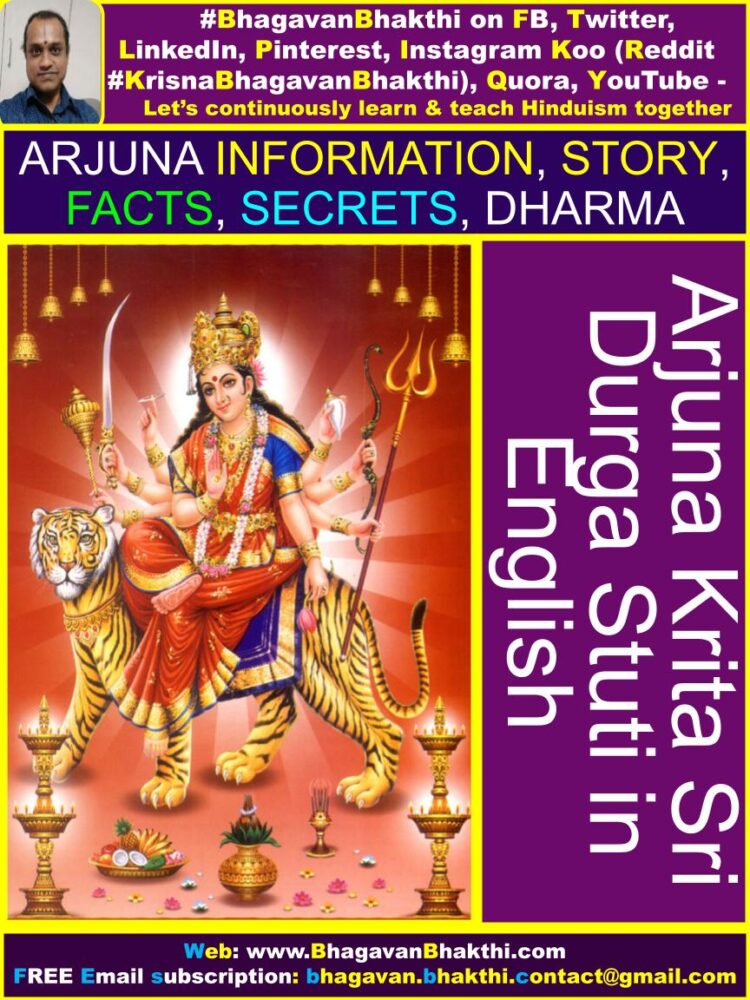
More information will be added to this on regular basis. Please visit this post after some time to get updated information.
To watch videos on #Hinduism #Sanskrit language, SUBSCRIBE to my YouTube channel from this below link:
#BhagavanBhakthi YouTube channel
To know more about “Pandavas information, secrets, facts, greatness, etc.“, please click the below link:
Pandavas information, secrets, facts, greatness, etc.
To know more information about “Why Krishna always helped Pandavas“, you can visit this below link:
Why Krishna always helped Pandavas
More information will be added to this. Please visit after some time.
Dear friends, if you need any clarifications about this post, kindly let me know, I will definitely try to answer all of them.
Also your one LIKE, one COMMENT, One Share, one SUBSCRIPTION is highly important.
This will help to know the quality of this content and also it will be helpful to know if any improvements is required for the content.
If you feel this content is useful to you and has helped you to improve your knowledge, kindly share this with your well-wishers.
Because “SHARING MEANS CARING”.
To receive FREE EMAIL SUBSCRIPTION about #BhagavanBhakthi, you can send an email to bhagavan.bhakthi.contact@gmail.com from your email ID.
NAMASTE!
Sri Gurubhyo Namaha
Sri Krishnaaya Namaha
Sri Krishnaarpanamastu